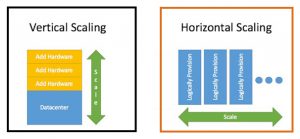When a company begins to expand, it should be as adaptable as possible. The growth of your business application will be accelerated as it scales, improving user experience and reaching a larger audience. In a nutshell, scalability enables you to better manage your application and respond to changing requirements. One of the first goals in developing a growth strategy for your company should be developing a scalable application.

What Do You Mean By Scalability?
Scalability refers to the ability to determine whether or not resources’ performance should be increased or decreased in response to current needs. Computing scaling in the cloud refers to monitoring the application’s needs by adding or deleting information resources based on the performance of the application. Scaling can be done in two ways, depending on the demands of the company i.e. horizontal and vertical scaling.
What Is Horizontal Scaling?
Horizontal scaling merely increases the number of machine instances without improving the existing specs. Scaling out allows you to distribute processing power and load balancing over several devices.
Horizontal scaling entails adding more machines to the resource pool as opposed to just scaling vertically. Vertical scaling allows you to zoom in to add more servers to your network, but it also demands you to zoom out by upgrading the existing infrastructure with more power, CPU, and RAM.
Horizontal scaling can be divided into three categories:
- Replication: The copying of data across servers is referred to as this word.
- Partitioning: The data is divided into portions according to some property in this scaling approach.
- Segmentation: It’s a database architecture technique in which distinct physical servers hold various parts of a table. For large-scale activities, segmentation is the best choice, especially when combined with replication. However, it is worth mentioning that this is a challenging task to plan because a server-to-server connection is required.
What Do You Mean By Vertical Scaling?
Vertical scaling preserves your current infrastructure while increasing processing power. You don’t have to update any of your existing code; all you have to do is run it on machines with improved specs. By scaling up, you can improve the capacity and throughput of a single system. Vertical scaling allows data to reside on a single node while scaling distributes the load among your computers’ CPU and RAM resources.
To cope with a rising workload, vertical scaling entails adding more resources to a single node, such as more CPU, RAM, and DISK. Vertical scaling essentially allows you to enhance the capacity of your present hardware or software, but keep in mind that you can only do so up to the constraints of your server.
This scaling also refers to raising the number of machines in a data center by providing more resources to single nodes — but without adding extra CPUs, memory, or hard drives — to boost capacity and allow each node to manage a higher workload.
Final Words
Most businesses fail to implement scalability because they do not recognize the current need for it. However, these groups overlook the fact that prevention is always preferable to cure. In this rapidly changing world, adopting a scalability strategy now would provide them an advantage over their competition. Users can choose between horizontal and vertical scaling depending on their needs, but at least one must be implemented.
